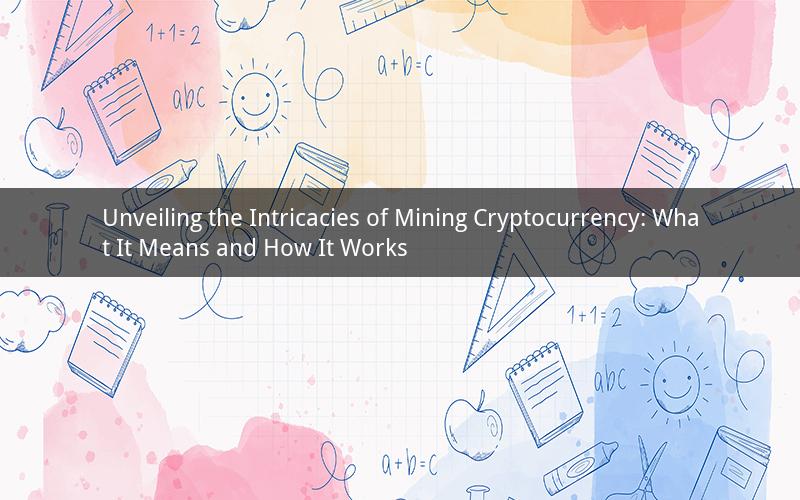
Introduction:
Cryptocurrency mining has become a buzzword in the world of digital finance. As the demand for cryptocurrencies continues to soar, many individuals and organizations are eager to understand what mining entails. This article delves into the concept of mining cryptocurrency, exploring its significance, process, and potential benefits.
1. What is Cryptocurrency Mining?
Cryptocurrency mining refers to the process of validating and adding new transactions to a blockchain. It involves using computational power to solve complex mathematical problems, which in turn rewards the miner with cryptocurrency tokens. The primary purpose of mining is to ensure the security, integrity, and decentralization of the blockchain network.
2. How Does Cryptocurrency Mining Work?
The process of mining cryptocurrency involves several steps:
a. Setting Up a Mining Rig:
To mine cryptocurrencies, you need a powerful computer known as a mining rig. This rig consists of multiple high-performance graphics processing units (GPUs) or application-specific integrated circuits (ASICs). These specialized components enable the rig to perform complex calculations at a high speed.
b. Joining a Mining Pool:
Mining solo can be challenging, as the chances of solving a mathematical problem and earning cryptocurrency are relatively low. To increase the likelihood of earning rewards, miners often join mining pools. A mining pool is a group of miners who combine their computational power to solve complex problems together. When a problem is solved, the rewards are distributed among the pool members based on their contribution.
c. Running the Mining Software:
Once you have set up your mining rig and joined a mining pool, you need to install mining software. This software connects your rig to the mining pool and allows it to participate in the mining process. The software also keeps track of your mining performance and rewards.
d. Solving Mathematical Problems:
Mining cryptocurrency requires solving complex mathematical problems. These problems are designed to be computationally intensive, ensuring that mining requires a significant amount of computational power. The first miner to solve a problem is rewarded with cryptocurrency tokens.
3. Why Mine Cryptocurrency?
Mining cryptocurrency offers several benefits:
a. Financial Rewards:
The primary motivation for mining cryptocurrency is the potential financial rewards. Miners are rewarded with cryptocurrency tokens for their computational power and efforts. However, the profitability of mining varies depending on factors such as the cost of electricity, the value of the cryptocurrency, and the difficulty of mining.
b. Security and Decentralization:
Mining plays a crucial role in maintaining the security and decentralization of the blockchain network. By solving mathematical problems, miners ensure that new transactions are added to the blockchain in a secure and transparent manner. This process also prevents double-spending and ensures the integrity of the network.
c. Contribution to the Network:
By mining cryptocurrency, you contribute to the growth and development of the blockchain network. Your computational power helps validate transactions and maintain the network's consensus mechanism.
4. Challenges and Risks of Mining Cryptocurrency
While mining cryptocurrency offers potential benefits, it also comes with challenges and risks:
a. High Costs:
Mining requires significant investment in hardware, electricity, and cooling systems. The cost of maintaining a mining rig can be substantial, especially considering the rising electricity prices and the need for efficient cooling solutions.
b. Market Volatility:
The value of cryptocurrencies can be highly volatile, impacting the profitability of mining. Fluctuations in the market can lead to significant financial gains or losses for miners.
c. Increasing Difficulty:
As more miners join the network, the difficulty of solving mathematical problems increases. This necessitates the use of more powerful and expensive mining equipment, further increasing the cost of mining.
5. Frequently Asked Questions (FAQs)
Q1: What is the most profitable cryptocurrency to mine?
A1: The profitability of mining varies depending on factors such as the cost of electricity, the value of the cryptocurrency, and the difficulty of mining. Currently, Ethereum and Bitcoin are among the most profitable cryptocurrencies to mine.
Q2: Can I mine cryptocurrency on my regular computer?
A2: While it is possible to mine cryptocurrency on a regular computer, the performance will be significantly lower compared to a dedicated mining rig. Mining on a regular computer may not be profitable due to the high electricity consumption and limited computational power.
Q3: How long does it take to mine a cryptocurrency?
A3: The time required to mine a cryptocurrency varies depending on the complexity of the mathematical problem and the computational power of your mining rig. On average, mining a cryptocurrency can take several hours, days, or even weeks.
Q4: Is mining cryptocurrency legal?
A4: The legality of mining cryptocurrency varies by country and region. In most countries, mining is legal, but it is essential to check the local regulations and ensure compliance with any applicable laws.
Q5: Can I mine cryptocurrency without a mining rig?
A5: Yes, it is possible to mine cryptocurrency without a mining rig by joining a cloud mining service. Cloud mining allows you to rent computational power from a remote data center and mine cryptocurrency remotely. However, it is crucial to research and choose reputable cloud mining providers to avoid scams.
Conclusion:
Mining cryptocurrency involves the process of validating and adding new transactions to a blockchain. By using computational power to solve complex mathematical problems, miners contribute to the security and decentralization of the network while earning cryptocurrency rewards. However, mining comes with challenges and risks, including high costs and market volatility. Understanding the intricacies of mining cryptocurrency is essential for individuals and organizations looking to participate in the digital finance revolution.